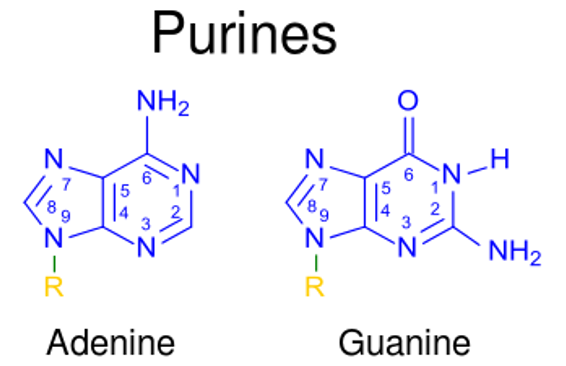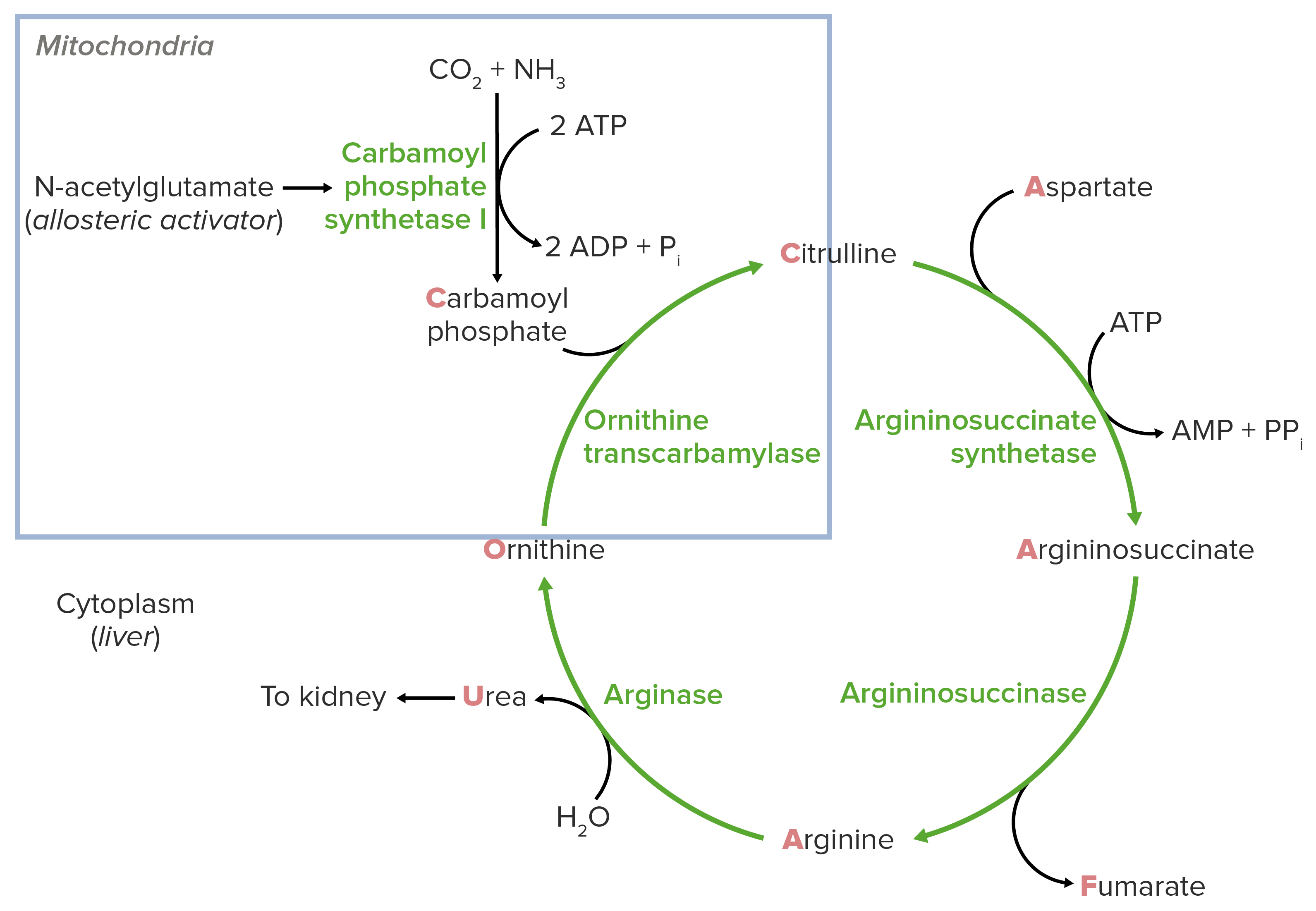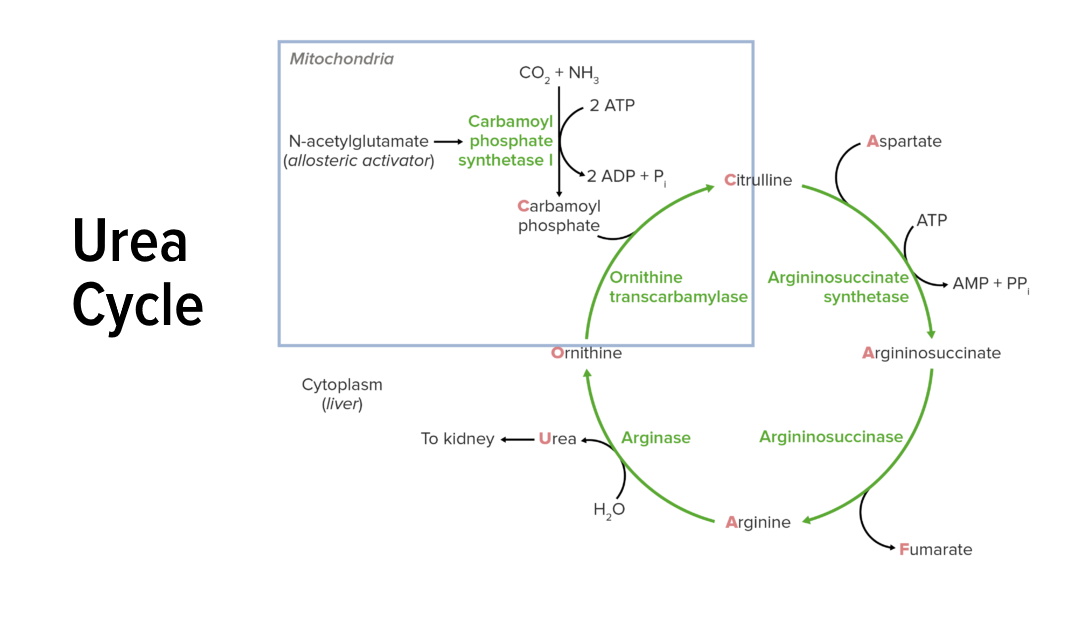Playlist
Show Playlist
Hide Playlist
Urea Cycle
-
Slides UreaCycle Biochemistry.pdf
-
Reference List Biochemistry.pdf
-
Download Lecture Overview
00:02 Well, the urea cycle is actually the place where the urea is made from that previous figure that I've just showed. 00:08 It's therefore important that we consider the reactions of the urea cycle in the slides ahead. 00:13 The urea cycle occurs primarily in the liver and also in the kidney as we saw. 00:18 The urea cycle consists of four different cycle reactions and one feeder reaction in the overall process as I will show you. 00:25 That involves five different enzymes. 00:27 The feeder reaction is shown at the top, and it involves the incorporation of one molecule of ammonia or ammonium, same thing, and one carbon dioxide. 00:37 That creates a molecule that then feeds into the cycle. 00:40 It's necessarily for that reaction to occur in order for the overall cycle to occur. 00:46 So this process I've just described involves then the incorporation of one ammonium ion from the feeder reaction and one amine from an amino acid. 00:54 In this way, both the amines and the ammonium ions get balanced. 00:59 So the output of the cycle is one molecule of urea per turn of the cycle, and that means that urea contain one of its nitrogens from ammonium and one of its nitrogens from amine. 01:10 The net reactions per turn of the cycle involve the incorporation of two amines, in this case NH3 coming from ammonium or NH2 that becomes NH3 coming from an amine. 01:22 Carbon dioxide is also needed, three ATPs and water. 01:27 That creates urea, two molecules of ADP, four phosphates, and an AMP. 01:33 Let's consider the reactions of the urea cycle. 01:37 You remember that the very first reaction is a feeder reaction. 01:39 It creates a molecule that then feeds into the overall cycle. 01:43 In that reaction, ammonium ion that's produced by the catabolic process of amino acid catabolism is combined with bicarbonate to make a molecule of carbamoyl phosphate. 01:55 That's feeder reaction is catalyzed by the enzyme carbamoyl phosphate synthethase. 02:00 In the next reaction, the carbamoyl phosphate is incorporated into the urea cycle by combining with the molecule of ornithine to make citrulline. 02:09 That reaction is catalyzed by the enzyme ornithine transcarbamoylase. 02:13 Now, the two reactions I've talked about here, the very first feeder reaction and the ornithine transcarbamoylase reaction occur in the mitochondrion because that's where those enzymes are located. 02:24 We now have citrulline which is a molecule that's part of the urea cycle and we'll follow through the rest of the reactions of the cycle. 02:31 In order for citrulline to react in the next part of the cycle, however, it must be moved from the mitochondria out into the cytoplasm where the other enzymes of the urea cycle are found. 02:42 Now, the reaction that creates the next intermediate is catalyzed by the enzyme argininosuccinate synthetase and creates the molecule argininosuccinate. 02:52 In the process of converting from citrulline to argininosuccinate, a transient covalent intermediate between citrulline and AMP is formed. 03:03 That actually occurs before the argininosuccinate can form. 03:07 And it's only after the aspartic acid is incorporated into the molecule that the AMP leaves. 03:15 So, let's look a little bit more closely on how that happens. 03:18 In this reaction, we see the intermediate on the side that has the AMP linked to the citrulline. 03:24 That AMP came from the ATP that you see in the addition reaction immediately above it. 03:30 In the next step of the process, aspartic acid comes in and displaces the AMP and becomes linked to the citrulline. 03:37 That's what actually creates the argininosuccinate. 03:41 In the next reaction, argininosuccinate is converted into arginine in a reaction catalyzed by argininosuccinate lyase. 03:49 In the process of making arginine, fumurate is released from argininosuccinate. 03:55 Now, what's happened in this last set of two reactions? In the formation of argininosuccinate, we saw an incorporation of aspartic acid or aspartate. 04:05 In the formation of arginine, we saw the release of fumurate So, the net sum of the two of those was we've incorporated carbons from aspartate. 04:14 And amine from an aspartate and we lose the carbons in the form of a furmurate. 04:19 In other words, we gained an amine. 04:22 Argininosuccinate is now carrying an amine from an amino acid. 04:26 You remember that in the urea cycle we get an ammonium ion which we've already seen in the feeder reaction and now we've incorporated the amine that we're going to use to make urea. 04:36 Well, the next process actually creates the urea. 04:40 Arginine is cleaved by the enzyme arginase to realease urea which can then go and be excreted in the urine and reproduce the ornithine that was necessary to continue the reaction that I've described at near the very beginning. 04:55 In order for that reaction to occur, ornithine must be transported back into the mitochondrion. 05:01 And we see that transport process happening right here.
About the Lecture
The lecture Urea Cycle by Kevin Ahern, PhD is from the course Amino Acid Metabolism.
Included Quiz Questions
Which of the following is true regarding the urea cycle?
- Two amines are used in the reaction that forms urea.
- It primarily occurs in the muscles.
- It generates ATP.
- Water is not needed for the reaction to occur.
- It outputs 3 amines per turn of the cycle.
Which of the following is NOT true of the urea cycle?
- The urea cycle takes place in the neuronal cells to get rid of the toxic effect of ammonium ions produced during amino acid catabolism.
- One urea molecule is produced per turn of the urea cycle.
- The urea cycle occurs in the cytoplasm and mitochondria of the liver and kidney cells.
- The net reaction for the urea cycle is 2NH3 + CO2 + 3ATP + H2O → CO(NH2)2 + 2ADP + 4Pi + AMP.
- In the urea cycle, the feeder reaction synthesizes the carbamoyl phosphate by incorporating ammonium and bicarbonate ions with the help of carbamoyl phosphate synthetase.
Which of the following is not correctly matched regarding the reactions and enzymes in the urea cycle?
- Ammonium ion + bicarbonate ion → carbamoyl phosphate — ornithine transcarbamoylase
- Carbamoyl phosphate + ornithine → citrulline — ornithine transcarbamoylase
- Citrulline + ATP + asparate → argininosuccinate + AMP + 2Pi — argininosuccinate synthetase
- Argininosuccinate → arginine + fumarate — argininosuccinate lyase
- Arginine + water → urea — arginase
Customer reviews
5,0 of 5 stars
| 5 Stars |
|
1 |
| 4 Stars |
|
0 |
| 3 Stars |
|
0 |
| 2 Stars |
|
0 |
| 1 Star |
|
0 |
Wow, these two amines are very tricky, thank you very much, Prof. Ahern!






